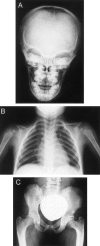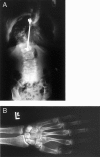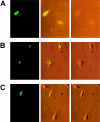Mutation analysis of core binding factor A1 in patients with cleidocranial dysplasia
- PMID: 10521292
- PMCID: PMC1288279
- DOI: 10.1086/302622
Mutation analysis of core binding factor A1 in patients with cleidocranial dysplasia
Abstract
Cleidocranial dysplasia (CCD) is a dominantly inherited disorder characterized by patent fontanelles, wide cranial sutures, hypoplasia of clavicles, short stature, supernumerary teeth, and other skeletal anomalies. We recently demonstrated that mutations in the transcription factor CBFA1, on chromosome 6p21, are associated with CCD. We have now analyzed the CBFA1 gene in 42 unrelated patients with CCD. In 18 patients, mutations were detected in the coding region of the CBFA1 gene, including 8 frameshift, 2 nonsense, and 9 missense mutations, as well as 2 novel polymorphisms. A cluster of missense mutations at arginine 225 (R225) identifies this residue as crucial for CBFA1 function. In vitro green fluorescent protein fusion studies show that R225 mutations interfere with nuclear accumulation of CBFA1 protein. There is no phenotypic difference between patients with deletions or frameshifts and those with other intragenic mutations, suggesting that CCD is generally caused by haploinsufficiency. However, we were able to extend the CCD phenotypic spectrum. A missense mutation identified in one family with supernumerary teeth and a radiologically normal skeleton indicates that mutations in CBFA1 can be associated exclusively with a dental phenotype. In addition, one patient with severe CCD and a frameshift mutation in codon 402 had osteoporosis leading to recurrent bone fractures and scoliosis, providing first evidence that CBFA1 may help maintain adult bone, in addition to its function in bone development.
Figures





Similar articles
-
A case of Japanese cleidocranial dysplasia with a CBFA1 frameshift mutation.J Craniofac Genet Dev Biol. 2000 Jul-Sep;20(3):121-6. J Craniofac Genet Dev Biol. 2000. PMID: 11321596
-
Missense mutations abolishing DNA binding of the osteoblast-specific transcription factor OSF2/CBFA1 in cleidocranial dysplasia.Nat Genet. 1997 Jul;16(3):307-10. doi: 10.1038/ng0797-307. Nat Genet. 1997. PMID: 9207800
-
[Clinical and image features, and identification of pathogenic gene mutation of two cleidocranial dysplasia families].Zhonghua Er Ke Za Zhi. 2010 Nov;48(11):834-8. Zhonghua Er Ke Za Zhi. 2010. PMID: 21215027 Chinese.
-
Cleidocranial dysplasia: clinical and molecular genetics.J Med Genet. 1999 Mar;36(3):177-82. J Med Genet. 1999. PMID: 10204840 Free PMC article. Review.
-
Mutations in the RUNX2 gene in patients with cleidocranial dysplasia.Hum Mutat. 2002 Mar;19(3):209-16. doi: 10.1002/humu.10043. Hum Mutat. 2002. PMID: 11857736 Review.
Cited by
-
The cleidocranial dysplasia-related R131G mutation in the Runt-related transcription factor RUNX2 disrupts binding to DNA but not CBF-beta.J Cell Biochem. 2010 May;110(1):97-103. doi: 10.1002/jcb.22516. J Cell Biochem. 2010. PMID: 20225274 Free PMC article.
-
Serine phosphorylation of RUNX2 with novel potential functions as negative regulatory mechanisms.EMBO Rep. 2002 Oct;3(10):967-74. doi: 10.1093/embo-reports/kvf193. Epub 2002 Sep 13. EMBO Rep. 2002. PMID: 12231506 Free PMC article.
-
Dysregulation of chondrogenesis in human cleidocranial dysplasia.Am J Hum Genet. 2005 Aug;77(2):305-12. doi: 10.1086/432261. Epub 2005 Jun 10. Am J Hum Genet. 2005. PMID: 15952089 Free PMC article.
-
Immortalized mouse floxed Bmp2 dental papilla mesenchymal cell lines preserve odontoblastic phenotype and respond to BMP2.J Cell Physiol. 2010 Oct;225(1):132-9. doi: 10.1002/jcp.22204. J Cell Physiol. 2010. PMID: 20458728 Free PMC article.
-
Genetic disorders of the skeleton: a developmental approach.Am J Hum Genet. 2003 Sep;73(3):447-74. doi: 10.1086/377110. Epub 2003 Jul 31. Am J Hum Genet. 2003. PMID: 12900795 Free PMC article. Review.
References
Electronic-Database Information
-
- GenBank, http://www.ncbi.nlm.nih.gov/Entrez/index.html (for sequences analyzed in this report [accession numbers AF001443–AF001450])
-
- Online Mendelian Inheritance in Man (OMIM), http://www.ncbi.nlm.nih.gov/Omim (for CCD [MIM 119600]) - PubMed
References
-
- Akeson AL, Wiginton DA, Hutton JJ (1989) Normal and mutant adenosine deaminase genes. J Cell Biochem 39:217–228 - PubMed
-
- Ducy P, Zhang R, Geoffroy V, Ridell AL, Karsenty G (1997) Osf2/Cbfa1: a transcriptional activator of osteoblast differentiation. Cell 89:747–754 - PubMed
-
- Geoffroy V, Corral DA, Zhou L, Lee B, Karsenty G (1998) Genomic organization, expression of the human CBFA1 gene, and evidence for an alternative splicing event affecting protein function. Mamm Genome 9:54–57 - PubMed
-
- Hashimoto S, Tsukada S, Matsushita M, Miyawaki T, Niida Y, Yachie A, Kobayashi S, et al (1996) Identification of Bruton's tyrosine kinase (Btk) gene mutations and characterization of the derived proteins in 35 X-linked agammaglobulinemia families: a nationwide study of Btk deficiency in Japan. Blood 88:561–573 - PubMed
Publication types
MeSH terms
Substances
Associated data
- Actions
- Actions
- Actions
- Actions
- Actions
- Actions
- Actions
- Actions
LinkOut - more resources
Full Text Sources
Other Literature Sources
Molecular Biology Databases

